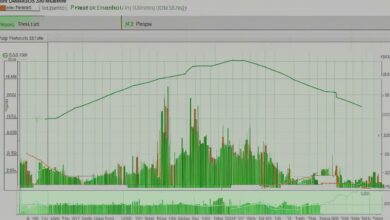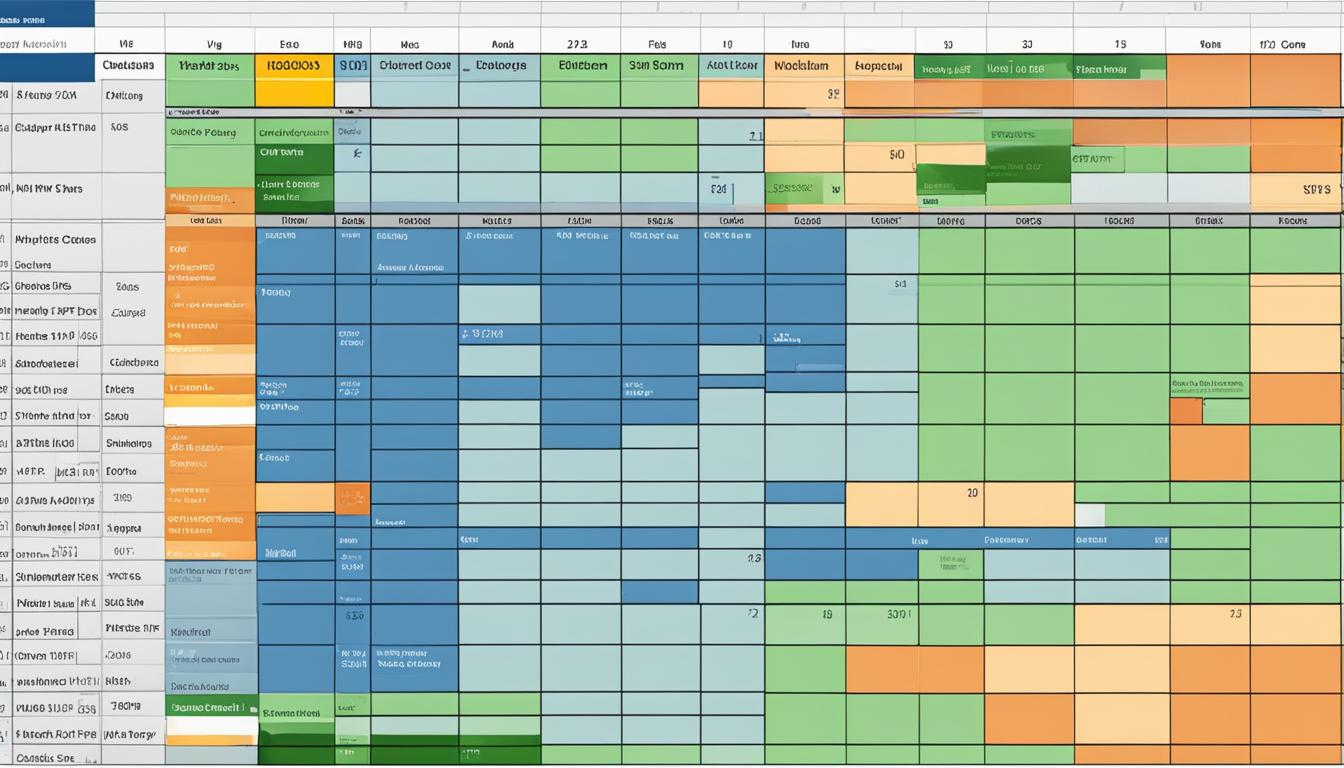Iron Butterfly: An Advanced Options Strategy

The iron butterfly strategy is a powerful and intricate options trading strategy that can provide both experienced and novice traders with a unique opportunity to generate steady income while managing risk. This sophisticated strategy involves combining a bear call spread with a bull put spread, resulting in a risk-defined position that can be employed during periods of lower price volatility.
Key Takeaways:
- The iron butterfly strategy combines a bear call spread with a bull put spread.
- It is a risk-defined position that can generate steady income.
- This strategy is best utilized during periods of lower price volatility.
- Traders employ the iron butterfly strategy when they believe the underlying asset will stay within a given price range.
- The iron butterfly strategy provides clearly defined risk and reward parameters.
Understanding the Iron Butterfly Strategy
The iron butterfly strategy is a type of options strategy known as a wingspread. It involves the combination of options contracts with different strike prices to create a unique trading position. The strategy gets its name from the shape it takes on a profit and loss graph, resembling the body and wings of a butterfly.
To construct an iron butterfly, a trader sells a short call and put at the middle strike price, while simultaneously buying a call and put above and below the middle strike. This results in a credit spread that pays the trader a net premium at the open. Unlike a basic butterfly spread that consists of three contracts, the iron butterfly requires four contracts.
The iron butterfly strategy is commonly used in options trading due to its potential to generate income while limiting risk. Traders typically employ this strategy when they anticipate the underlying asset to stay within a specific price range until the options’ expiration date. The closer the asset closes to the middle strike price at expiration, the higher the potential profit. However, if the price closes above the upper call strike or below the lower put strike, the trader will experience a loss.
Example of an Iron Butterfly Strategy:
Let’s consider a hypothetical iron butterfly trade on stock XYZ:
Option Strike Price Premium Sell Call $50 $2.00 Buy Call $55 $1.00 Sell Put $50 $1.50 Buy Put $45 $1.50 In this example, the trader receives a net credit of $2.00 for opening the iron butterfly. The maximum possible profit is the total premium received, $2.00, and the maximum risk is the difference between the strike prices of the long and short options, minus the premium received. If the stock price closes at the middle strike price of $50 at expiration, the trader will achieve the maximum profit. However, if the stock price closes outside the range of $45 to $55, the trader will incur a loss.
The iron butterfly strategy offers traders both advantages and disadvantages. While it can provide potential steady income and has clearly defined risk and reward parameters, traders must also consider commission costs and the fact that the maximum profit is seldom earned. It is crucial for traders to carefully evaluate the strategy and its suitability for their trading goals before implementing it.
How to Use the Iron Butterfly Strategy
The iron butterfly strategy is an options trading strategy that can be used when a trader believes that the underlying asset will stay within a specific price range until the options’ expiration date. This strategy involves selling a short call and put at the middle strike price, while simultaneously buying a call and put above and below the middle strike price. The goal of this strategy is to generate income through the premium received, while limiting both potential profit and risk.
Traders who employ the iron butterfly strategy hope that the underlying asset will close near the middle strike price at expiration. This is because the closer the price is to the middle strike price, the higher the profit. However, if the price closes above the strike price of the upper call or below the strike price of the lower put, the trader will incur a loss.
The iron butterfly strategy provides traders with a risk-defined position. The breakeven points can be calculated by adding or subtracting the premium received from the middle strike price. This strategy is often used during periods of lower price volatility when the trader expects the underlying asset to remain relatively stable. It is important to note that the iron butterfly strategy requires experience and knowledge of options trading.
Example of the Iron Butterfly Strategy:
Let’s say an options trader believes that a particular stock will remain within a price range of $50 to $60 until the options’ expiration date. They could choose to implement the iron butterfly strategy as follows:
- Sell a short call option with a strike price of $55
- Buy a call option with a strike price of $60
- Sell a short put option with a strike price of $55
- Buy a put option with a strike price of $50
By executing these four options contracts, the trader has created an iron butterfly position. If the underlying stock price remains between $55 and $60 at expiration, the trader can realize the maximum profit. However, if the stock price falls below $50 or rises above $60, the trader may experience a loss.

| Options | Strike Price | Premium |
|---|---|---|
| Short Call | $55 | +$2 |
| Long Call | $60 | -$1 |
| Short Put | $55 | +$2 |
| Long Put | $50 | -$1 |
In this example, the trader receives a net premium of $3 when opening the iron butterfly position. The maximum profit is the premium received ($3), and the maximum loss is the difference between the strike prices ($5) minus the premium received ($3), resulting in a maximum loss of $2. The breakeven points for this iron butterfly position would be $52 on the downside and $58 on the upside.
Advantages and Disadvantages of the Iron Butterfly Strategy
The iron butterfly strategy offers several advantages and disadvantages that traders should consider before implementing it. Understanding these factors can help traders make informed decisions and manage their risk effectively.
Advantages of the Iron Butterfly Strategy
- Steady Income: One of the primary advantages of the iron butterfly strategy is the potential for steady income. By selling options contracts and collecting premiums, traders can generate consistent cash flow.
- Risk-Defined: The iron butterfly strategy is a risk-defined position, which means that traders have a clear understanding of the maximum risk they can incur. This risk is typically limited to the difference between the strike prices of the options contracts involved in the strategy.
- Ability to Roll or Adjust: Another advantage of the iron butterfly strategy is the ability to roll or adjust the position if needed. Traders can make changes to their position to adapt to market conditions, potentially minimizing losses or maximizing profits.
Disadvantages of the Iron Butterfly Strategy
- Commission Costs: It is important to consider commission costs when trading iron butterflies. Since this strategy involves opening and closing four positions, traders may incur higher commission costs compared to simpler options strategies.
- Maximum Profit Potential: While the iron butterfly strategy offers a steady income, the maximum profit potential is seldom earned. This is because the underlying asset typically settles between the middle strike price and either the upper or lower limit, resulting in less profit than the maximum achievable.
In summary, the iron butterfly strategy provides traders with the potential for steady income and risk-defined parameters, allowing them to manage their risk effectively. However, it is important to consider commission costs and the realistic profit potential when implementing this strategy.

Market Outlook for Iron Butterfly Trades
The iron butterfly strategy is a market neutral options trading strategy that aims to profit from a decrease in volatility and the minimal movement of the underlying asset. It is designed for traders who anticipate that the price of the underlying asset will remain range-bound before the expiration of the options. By constructing the iron butterfly using a short straddle and long options on the wings, traders can protect against significant price movements while still benefiting from time decay.
This strategy is particularly useful in periods of lower price volatility, as it allows traders to generate income by selling the short straddle and collecting a net premium. The maximum profit for an iron butterfly is achieved when the underlying asset closes exactly at the middle strike price on the expiration day. The break-even points can be calculated by adding or subtracting the total credit received from the premium.

To implement an iron butterfly trade successfully, traders should consider the market outlook and potential factors that may affect volatility. It is important to monitor any news or events that could significantly impact the underlying asset and adjust the strategy accordingly. Additionally, traders should regularly assess the options’ implied volatility and time decay to gauge the potential profitability of the iron butterfly trade.
Overall, iron butterfly trades provide traders with a risk-defined position and the potential for steady income. However, it is essential to thoroughly understand the strategy’s mechanics, risks, and potential rewards before implementing it. Traders should also be aware of the requirements and restrictions imposed by brokerage platforms, as they may have specific skill level and financial requirements for trading iron butterflies or similar strategies.
Setting Up an Iron Butterfly Trade
Setting up an iron butterfly trade involves strategically combining multiple options contracts to create a risk-defined position. This advanced options strategy requires careful consideration of spread width, maximum profit, and maximum risk. The goal is to generate income while limiting potential losses.
To set up an iron butterfly trade, a trader begins by selling an at-the-money short straddle, which consists of selling a call and put option with the same strike price and expiration date. The trader then buys out-of-the-money options on the wings, purchasing a call and put option above and below the short straddle’s strike price.
The spread width of the iron butterfly is determined by the difference in strike prices between the short straddle and the purchased wing options. This width defines the maximum risk for the strategy. The wider the spread, the higher the risk, but also the greater the potential profit. It is important to find a balance between risk and reward that aligns with your trading goals and risk tolerance.
| Component | Action |
|---|---|
| Sell short straddle | Sell at-the-money call and put options |
| Buy wing options | Purchase out-of-the-money call and put options above and below the short straddle’s strike price |
| Spread width | Difference in strike prices between the short straddle and wing options |
| Risk | Defined by the spread width |
| Maximum profit | Combined credit of the spreads |
By setting up an iron butterfly trade, traders can take advantage of a risk-defined position while potentially earning income from the net premium received at open. However, it is important to closely monitor the trade, as the underlying asset’s price movement can impact the profitability of the strategy. Traders may need to make adjustments or consider exiting the trade if market conditions change significantly.

Summary:
- An iron butterfly trade involves selling an at-the-money short straddle and buying out-of-the-money wing options.
- The spread width, determined by the difference in strike prices, defines the maximum risk for the strategy.
- The maximum profit is the combined credit of the spreads.
- Traders should carefully consider their risk tolerance and trading goals when setting up an iron butterfly trade.
Iron Butterfly Payoff Diagram
The iron butterfly strategy is known for its well-defined payoff diagram. Like the wings of a butterfly, this options strategy offers specific profit and loss areas, with break-even points that can be easily identified. Understanding the payoff diagram is essential for traders looking to implement the iron butterfly strategy effectively.
The iron butterfly strategy earns its maximum profit when the underlying asset closes exactly at the middle strike price on the expiration day. In this scenario, the options contracts at the upper and lower strikes expire worthless, allowing the trader to keep the premium collected from selling those contracts. The profit in this case is equal to the net premium earned.
The break-even points of the iron butterfly strategy can be calculated by adding or subtracting the total credit received from the middle strike price. These break-even points determine the price range within which the trader will neither make nor lose money. If the underlying asset closes within this range on the expiration day, the trader can earn a profit. However, if the asset price deviates too much from the middle strike, the trader may incur losses.
| Profit/Loss Areas | Price Range |
|---|---|
| Maximum Profit | Between the two break-even points |
| Losses | Below the lower break-even point or above the upper break-even point |
| Maximum Loss | When the underlying asset price is below the lower strike price or above the upper strike price |
By visualizing the iron butterfly payoff diagram and understanding the profit and loss areas, traders can make informed decisions about when to enter, exit, or adjust their positions. This diagram serves as a valuable tool in managing the risks and rewards associated with the iron butterfly strategy.
Exiting and Adjusting an Iron Butterfly Trade
When it comes to managing iron butterfly trades, traders have several options for exiting or adjusting their positions. The decision to exit or make adjustments will depend on market conditions, risk tolerance, and the trader’s overall strategy.
One approach is to exit the entire iron butterfly trade before the expiration date. This can be done by simultaneously closing all four positions – the short call, long call, short put, and long put. Exiting the trade early allows the trader to lock in any profits or limit potential losses based on the current market conditions.
Alternatively, traders can choose to exit only a portion of the iron butterfly trade if they believe that one side of the position is no longer viable. For example, if the underlying asset’s price moves significantly above the upper call strike price, the trader can choose to close out the short call position while keeping the remaining legs of the iron butterfly trade open. This adjustment reduces risk and allows the trader to potentially profit from any further price movement within the desired range.
If adjustments are needed to manage risk or extend the time horizon of the trade, traders can consider rolling the iron butterfly position. Rolling involves closing out the current position and opening a new one with different strike prices or expiration dates. By rolling the trade, the trader can adjust the position to better align with changing market conditions and potentially increase the overall profitability of the trade.

| Exit/Adjustment Strategy | Description |
|---|---|
| Early Exit | Close the entire iron butterfly trade before expiration to lock in profits or limit losses. |
| Partial Exit | Close only one side of the iron butterfly trade if it is no longer viable, while keeping the remaining legs open. |
| Rolling the Trade | Close the current iron butterfly position and open a new one with different strike prices or expiration dates to better align with market conditions. |
“Exiting and adjusting an iron butterfly trade requires careful consideration of market conditions and risk management. Traders should closely monitor the underlying asset’s price movement and be prepared to take action if necessary. Whether it’s closing the entire position, adjusting one side of the trade, or rolling the position, it’s important to have a plan in place and stick to it.”
Time Decay and Implied Volatility Impact on Iron Butterfly Trades
Time decay and implied volatility play crucial roles in the success of iron butterfly trades. Understanding how these factors influence options premiums is essential for traders looking to maximize their profits and minimize risk.
Time Decay
Time decay, also known as theta decay, refers to the gradual erosion of an option’s time value as it gets closer to expiration. This decay accelerates as the expiration date approaches. For iron butterfly trades, time decay is beneficial as it works in favor of the trader.
As time passes, the time value of options decreases, which can lead to a decrease in option premiums. This decrease in premiums allows traders to potentially buy back the options for less money than they initially sold. Therefore, iron butterfly traders can take advantage of time decay by waiting for the options to lose value before closing their positions.
Implied Volatility
Implied volatility is a measure of the market’s expectation for future price fluctuations. It is a crucial consideration for options traders, as it directly impacts the price of options contracts. When implied volatility increases, the price of options rises, and when implied volatility decreases, the price of options falls.
Iron butterfly trades benefit from a decrease in implied volatility. Lower implied volatility results in lower option premiums, which can be advantageous for traders looking to buy back options at a lower cost. Traders can take advantage of decreases in implied volatility by waiting for a decrease in option premiums before closing their iron butterfly positions.
| Factors | Impact on Iron Butterfly Trades |
|---|---|
| Time Decay | Works in favor of the trader, as time passes, the time value of options decreases, potentially leading to lower option premiums. |
| Implied Volatility | A decrease in implied volatility results in lower option premiums, allowing traders to potentially buy back options at a lower cost. |
By understanding and capitalizing on the impact of time decay and implied volatility, traders can enhance their iron butterfly strategies and improve their chances of earning profits. However, it is important to closely monitor these factors, as changes in market conditions can significantly impact the success of iron butterfly trades.

Hedging Strategies for Iron Butterfly Trades
When trading iron butterfly strategies, it’s essential to have a plan in place to protect against price movements and manage risk effectively. One common hedging strategy is rolling spreads, which involves adjusting the position as the market evolves.
Rolling Spreads
Rolling spreads is a technique used to extend the time horizon of an iron butterfly trade and potentially increase the amount of credit received. It involves closing the current position and opening a new one with a different expiration date. By doing so, the trader can adapt to changing market conditions and take advantage of additional premium opportunities.
When rolling spreads, it’s important to monitor the price movement of the underlying asset. If the market moves against the position, the unchallenged spread can be rolled in the direction of the price movement. This adjustment helps to mitigate losses and maintain a risk-defined position.
Protecting Against Price Movement
In addition to rolling spreads, traders can use other hedging strategies to protect against price movement when trading iron butterflies. These strategies may include adjusting the strike prices of the options, adding or removing options contracts, or implementing stop-loss orders to limit potential losses.
It’s important to note that while hedging strategies can help manage risk, they may result in an inverted position where the short call is below the short put. Traders should carefully consider the potential impact of these adjustments and evaluate the risk-reward profile of the trade.

| Iron Butterfly Hedging Strategies | Pros | Cons |
|---|---|---|
| Rolling Spreads | Allows for time horizon extension and potential increase in credit received | May result in an inverted position and increased risk |
| Adjusting Strike Prices | Provides flexibility to adapt to changing market conditions | May reduce potential profits |
| Adding or Removing Options Contracts | Allows for position customization based on market outlook | Can increase trading costs and complexity |
| Stop-Loss Orders | Provides a predefined exit point to limit potential losses | May result in exiting the trade too early |
Conclusion
The iron butterfly strategy is an advanced options strategy that offers traders the potential for steady income while limiting risk. It combines bear call spreads and bull put spreads to create a risk-defined position that aims to profit from a range-bound underlying asset. By using this strategy, traders can take advantage of periods of lower price volatility.
Before implementing the iron butterfly strategy, it is important for traders to thoroughly understand the risks and rewards involved. While this strategy provides several advantages, such as clearly defined risk and reward parameters and the ability to adjust or roll the position if needed, traders should also consider the commission costs associated with opening and closing four positions.
To trade iron butterflies or similar strategies, most brokerage platforms require clients to meet certain skill level and financial requirements. It is crucial for traders to ensure they meet these criteria before engaging in such advanced options strategies.
FAQ
What is the iron butterfly strategy?
The iron butterfly strategy is a complex options trading strategy that involves combining a bear call spread with a bull put spread. It is designed to generate steady income while limiting both risk and potential profit.
How does the iron butterfly strategy differ from a basic butterfly spread?
The iron butterfly strategy differs from the basic butterfly spread in that it is a credit spread that pays the investor a net premium at open and requires four contracts instead of three.
When should I use the iron butterfly strategy?
The iron butterfly strategy is best employed during periods of lower price volatility when the trader believes the underlying asset will stay within a given price range through the options’ expiration date.
What are the benefits of the iron butterfly strategy?
The iron butterfly strategy provides several key benefits, including potential steady income, clearly defined risk and reward parameters, and the ability to roll or adjust the position if needed.
What are the breakeven points for the iron butterfly strategy?
The breakeven points for the iron butterfly strategy can be calculated by adding and subtracting the premium received from the middle strike price.
How does the iron butterfly strategy profit from a decrease in volatility?
Iron butterflies are market neutral strategies that aim to profit from a decrease in volatility and minimal movement of the underlying asset. They are constructed using a short straddle and long options on the wings, which provide protection against significant price movements.
How do I set up an iron butterfly trade?
To set up an iron butterfly trade, a trader sells an at-the-money short straddle and buys out-of-the-money options on the wings with the same expiration date.
What is the maximum profit for an iron butterfly trade?
The maximum profit for an iron butterfly trade is defined by the combined credit of the spreads.
How can I exit or adjust an iron butterfly trade?
Traders can exit an iron butterfly trade either before expiration or on the expiration day. They can choose to close the entire position, one spread, or just the short options. If adjustments are needed, the trader can roll the unchallenged spread in the direction of price movement or apply other adjustment strategies to extend the time horizon or limit risk.
How does time decay and implied volatility impact iron butterfly trades?
Iron butterflies benefit from time decay and a decrease in implied volatility. As time passes, the time value of the options decreases, which can work to the trader’s advantage. Lower implied volatility results in lower option premiums, allowing the trader to potentially buy back the options for less money than initially sold.
How can I hedge an iron butterfly trade?
To hedge an iron butterfly trade, a trader can roll the unchallenged spread in the direction of price movement. By adjusting the position, the trader can increase the amount of credit received and potentially minimize risk.







